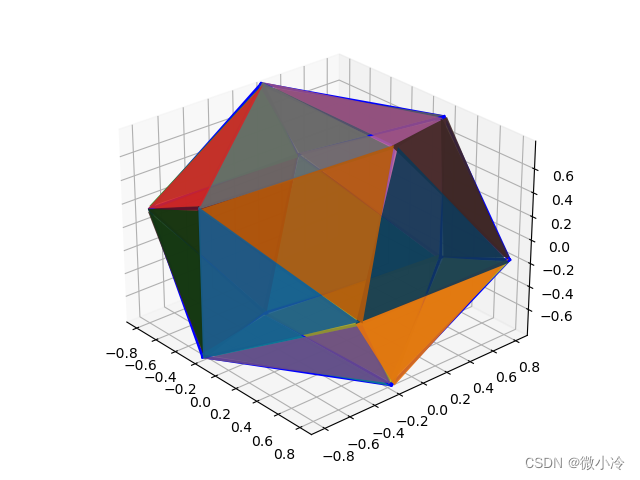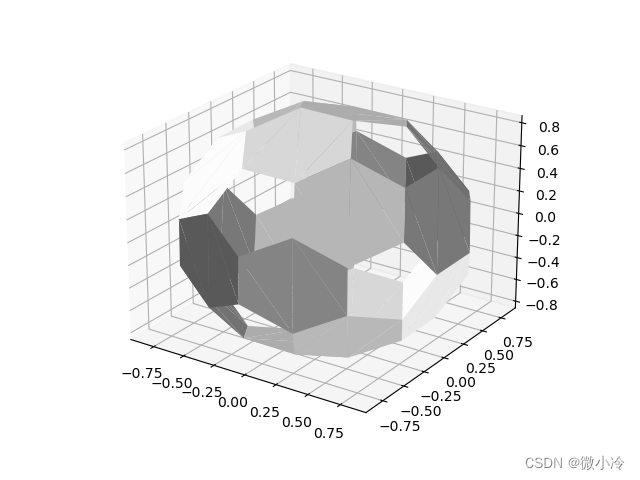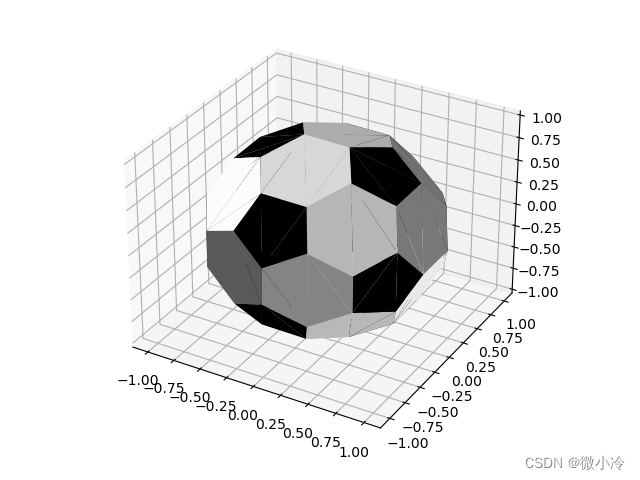前情提要
如果想优雅地绘制一个足球,那首先需要绘制正二十面体:用Python绘制正二十面体
其核心代码为
|
1
2
3
4
5
6
7
8
9
10
11
12
13
14
15
16
17
18
19
20
21
22
23
24
25
26
27
28
29
30
31
32
33
|
import numpy as np
from itertools import product
G = (np.sqrt(5)-1)/2
def getVertex():
pt2 = [(a,b) for a,b in product([1,-1], [G, -G])]
pts = [(a,b,0) for a,b in pt2]
pts += [(0,a,b) for a,b in pt2]
pts += [(b,0,a) for a,b in pt2]
return np.array(pts)
def getDisMat(pts):
N = len(pts)
dMat = np.ones([N,N])*np.inf
for i in range(N):
for j in range(i):
dMat[i,j] = np.linalg.norm([pts[i]-pts[j]])
return dMat
pts = getVertex()
dMat = getDisMat(pts)
# 由于存在舍入误差,所以得到的边的数值可能不唯一
ix, jx = np.where((dMat-np.min(dMat))<0.01)
# 获取正二十面体的边
edges = [pts[[i,j]] for i,j in zip(ix, jx)]
def isFace(e1, e2, e3):
pts = np.vstack([e1, e2, e3])
pts = np.unique(pts, axis=0)
return len(pts)==3
from itertools import combinations
# 获取正二十面体的面
faces = [es for es in combinations(edges, 3)
if isFace(*es)]
|
为了克服plot_trisurf在xy坐标系中的bug,需要对足球做一点旋转,所以下面要写入旋转矩阵。
|
1
2
3
4
5
6
7
8
9
10
11
12
13
14
15
16
17
18
|
# 将角度转弧度后再求余弦
cos = lambda th : np.cos(np.deg2rad(th))
sin = lambda th : np.sin(np.deg2rad(th))
# 即 Rx(th) => Matrix
Rx = lambda th : np.array([
[1, 0, 0],
[0, cos(th), -sin(th)],
[0, sin(th), cos(th)]])
Ry = lambda th : np.array([
[cos(th), 0, sin(th)],
[0 , 1, 0],
[-sin(th), 0, cos(th)]
])
Rz = lambda th : np.array([
[cos(th) , sin(th), 0],
[-sin(th), cos(th), 0],
[0 , 0, 1]])
|
最后得到的正二十面体为

先画六边形
足球其实就是正二十面体削掉顶点,正二十面体有20个面和12个顶点,每个面都是三角形。削掉顶点对于三角形而言就是削掉三个角,如果恰好选择在1/3的位置削角,则三角形就变成正六边形;而每个顶点处刚好有5条棱,顶点削去之后就变成了正五边形。
而正好足球的六边形和五边形有着不同的颜色,所以可以分步绘制,先来搞定六边形。
由于此前已经得到了正二十面体的所有面,同时还有这个面对应的所有边,故而只需在每一条边的1/3 和2/3处截断,就可以得到足球的正六边形。
|
1
2
3
4
5
6
7
8
9
10
11
12
|
def getHexEdges(face):
pts = []
for st,ed in face:
pts.append((2*st+ed)/3)
pts.append((st+2*ed)/3)
return np.vstack(pts)
ax = plt.subplot(projection='3d')
for f in faces:
pt = getHexEdges(f)
pt = Rx(1)@Ry(1)@pt.T
ax.plot_trisurf(*pt, color="white")
|
于是,一个有窟窿的足球就很轻松地被画出来了

再画五边形
接下来要做的是,将五边形的窟窿补上,正如一开始说的,这个五边形可以理解为削去顶点而得到的,所以第一件事,就是要找到一个顶点周围的所有边。具体方法就是,对每一个顶点遍历所有边,如果某条边中存在这个顶点,那么就把这个边纳入到这个顶点的连接边。
|
1
2
3
4
5
6
7
8
9
10
11
12
13
14
|
def getPtEdges(pts, edges):
N = len(pts)
pEdge = [[] for pt in pts]
for i,e in product(range(N),edges):
if (pts[i] == e[0]).all():
pt = (2*pts[i]+e[1])/3
elif (pts[i] == e[1]).all():
pt = (2*pts[i]+e[0])/3
else:
continue
pEdge[i].append(pt)
return np.array(pEdge)
pEdge = getPtEdges(pts, edges)
|
接下来,就可以绘制足球了
|
1
2
3
4
5
6
7
8
9
10
11
|
ax = plt.subplot(projection='3d')
for f in faces:
pt = getHexEdges(f)
pt = Rx(1)@Ry(1)@pt.T
ax.plot_trisurf(*pt, color="white")
for pt in pEdge:
pt = Rx(1)@Ry(1)@pt.T
ax.plot_trisurf(*pt, color="black")
plt.show()
|
效果为

|